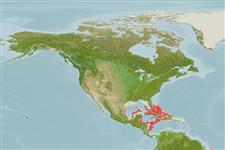Teleostei (teleosts) >
Ovalentaria/misc (Various families in series Ovalentaria) >
Grammatidae (Basslets)
Etymology: Lipogramma: Name formed from 'lipo' for 'without' and 'gramma' for 'a line of text', referring to the absence of a well-developed lateral line.
Environment: milieu / climate zone / depth range / distribution range
Ecology
Marine; demersal; depth range 180 - 290 m (Ref. 26884). Deep-water
Western Central Atlantic: Bahamas and Belize.
Size / Weight / Age
Maturity: Lm ? range ? - ? cm
Max length : 2.2 cm SL male/unsexed; (Ref. 26884)
Life cycle and mating behavior
Maturity | Reproduction | Spawning | Eggs | Fecundity | Larvae
Gilmore, R.G., 1997. Lipogramma robinsi, a new basslet from the tropical western Atlantic, with descriptive and distributional notes on L. flavescens and L. anabantoides (Perciformes: Grammatidae). Bull. Mar. Sci. 60(3):782-788. (Ref. 26884)
IUCN Red List Status (Ref. 130435: Version 2024-1)
Threat to humans
Harmless
Human uses
Fisheries: of potential interest
Tools
Special reports
Download XML
Internet sources
Estimates based on models
Preferred temperature (Ref.
123201): 13.5 - 22.7, mean 19 °C (based on 19 cells).
Phylogenetic diversity index (Ref.
82804): PD
50 = 0.5003 [Uniqueness, from 0.5 = low to 2.0 = high].
Bayesian length-weight: a=0.01122 (0.00514 - 0.02450), b=3.04 (2.87 - 3.21), in cm total length, based on all LWR estimates for this body shape (Ref.
93245).
Trophic level (Ref.
69278): 3.1 ±0.4 se; based on size and trophs of closest relatives
Fishing Vulnerability (Ref.
59153): Low vulnerability (10 of 100).
